- Cranko. The Man and his Choreography. A new book
A new book, Cranko. The Man and his Choreography by Ashley Killar is due to be released in London next month. Killar, who danced extensively with Stuttgart Ballet when John Cranko was the company’s artistic director, presents a detailed and extensively researched analysis of the life and career of Cranko, going right back to his childhood in South Africa. The book will also have an Australian launch in December, coinciding with the production of Cranko’s Romeo and Juliet as part of the Australian Ballet’s Sydney season. At present the book can be pre-ordered from Book Depository or from the British publisher at this link. In Australia it will initially be available through Bloch Dance stores.


Read more about the book at this link, where you’ll find some unexpected items, including recipes (and see above an image of Cranko as chef).
- Douglas Wright’s Gloria
The latest news from CO3, the Perth-based contemporary company led by Raewyn Hill, is that the company will be staging Douglas Wright’s Gloria in September.

Here is what Jennifer Shennan wrote about Gloria in 2004, which she updated for Raewyn Hill just recently:
Gloria—by Douglas Wright & Antonio Vivaldi
To Vivaldi’s exuberant music, Douglas Wright made Gloria, the best dance ever choreographed in New Zealand. It affirms and celebrates life as it is on Earth. Dancers clad in gold silk launch themselves into the air and seem to stay there, flying over each other in twists and plaits, bodies somehow freed from gravity, aiming for the stars, hitting the sun.
Douglas was commissioned by his friend Helen Aldridge to choreograph a work commemorating the life of her daughter, and also his friend, Deirdre Mummery, who had died of an accidental drug overdose.
Helen did not know what might result—a lament? an elegy? commiseration? She could scarcely have imagined the ecstasy and expression of life’s force as these exquisite dancers walk then run, lean then leap, lift then fall, roll then rise, turn then hold, shimmer then fly.
The physical stamina required is phenomenal but not for a moment do we sense any struggle. The choreography is woven of exquisite lines and loops, allowing the dancers to embrace every baroque quaver in the light and shade of Vivaldi’s Gloria. It affirms and celebrates life as it is in Heaven, where Deirdre and Douglas now live.
Written by Jennifer Shennan in 2004, for BEST—a New Zealand compendium [AWA Press 2004]; reworked for Raewyn Hill, August 2022
My review from 1993, when Gloria was staged by Sydney Dance Company along with Graeme Murphy’s Protecting Veil, is at this link. See also the tag Douglas Wright for more about Wright’s work as it appears on this website.
Further information about the CO3 staging is available on the company’s website.
- News from James Batchelor
Short Cuts to Familiar Places, James Batchelor’s latest work, will receive its world premiere in Düsseldorf, Germany, in October. The work investigates the concept of ‘body lineage’ and, in his media release, Batchelor describes it as exploring ‘the idea of the body as a site of inscription, a morphing map or text that is continuously re-drawn and re-written’.
Batchelor has been researching the background for this work for a year or so now and he has given particular focus to the work of his teacher at Canberra’s QL2, Ruth Osborne, and her connections through her own teacher, Margaret Chapple. Chappie, as she was familiarly known, was a student of and dancer with Gertrud Bodenwieser and, after Bodenwieser’s death, directed (with Keith Bain) the Bodenwieser Dance Centre in Sydney. Batchelor has also worked with, and considered the heritage of others with connections to Bodenwieser including Eileen Kramer and Carol Brown.

With luck Short Cuts to Familiar Places will eventually be shown in Australia. Stay tuned.
Production credits (from the media release):
CHOREOGRAPHY, PERFORMANCE James Batchelor DRAMATURGY, PRODUCTION Bek Berger COMPOSITION Morgan Hickinbotham PERFORMANCE Chloe Chignell LIGHT DESIGN Vinny Jones COSTUME DESIGN Juliane König CHOREOGRAPHIC CONSULTATION Ruth Osborne, Eileen Kramer, Carol Brown RESEARCH CONSULTATION Michelle Potter
- The end of an era?
It was something of a shock to learn that the world renown dance magazine Dancing Times will publish its very last issue next month, September 2022. The London-based magazine with an international reach was established in 1910 when its predecessor, a house magazine of the Cavendish Rooms, was bought by founding Dancing Times editor P. J. S. Richardson. Since then it has had other editors with the present holder of the position being Jonathan Gray. Current production editor of the magazine, Simon Turner, writes:
Sadly, since 2020, the tremendous economic impact of the coronavirus pandemic, as well as the rapid increase in costs over the past year, means that the magazine is no longer financially viable in its current form.
The news has shocked the international dance world of course and we have to hope that the same fate does not occur with Dance Australia, which already has reduced its schedule from a print version every two months to one every three months.
*********************
But on different although related issue, dance reviews and articles in print outlets in Australia (and elsewhere?), especially those by knowledgeable contributors, seem to be slowly disappearing. Another end to an era? I was struck by a recent notification from the Sydney Opera House of an event due to take place in September called ‘How do you solve a problem like the media?’ Despite the clear allusion in the title to a well-known song and by extension to the arts, this event appears to be focusing on politics, with which I have no issues of course. But the opening remark in the advertisement for the occasion, ‘The media has gone through a huge upheaval in recent decades. Now we’re starting to see the effects …’, applies equally to the arts, and to dance in particular, which scarcely ever gets an informed and in depth mention, even in online outlets associated with newspapers.
- Liz Lea at the Edinburgh Fringe
As mentioned in the July dance diary, Liz Lea’s RED was set to be part of this year’s Edinburgh Fringe and RED took the stage from 16-28 August. Read Helen Musa’s review of the Edinburgh show for Canberra City News at this link. And in the light of my comments above re the disappearance of the arts from print outlets, we are lucky in Canberra that City News, which has a weekly print edition as well as an online presence, still sees fit to carry news and reviews about the arts, including dance.
- Glimpses of Graeme. Another new book
My next book is currently being designed, although a release date is not yet available. Called Glimpses of Graeme. Reflections on the work of Graeme Murphy, it consists of a selection of reviews and articles I have written about Murphy and his works. Rather than gathering the pieces together chronologically, as is often the case with such collections, I have arranged them in chapters that reflect themes that I believe characterise Murphy’s oeuvre. More later.
Michelle Potter, 31 August 2022
Featured image: The chair Cranko used for rehearsals in Stuttgart. From Ashley Killar’s website regarding his book.
